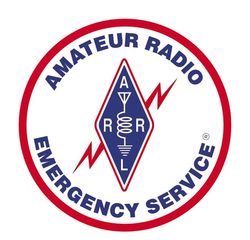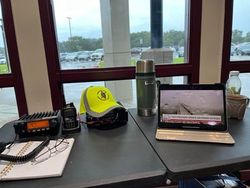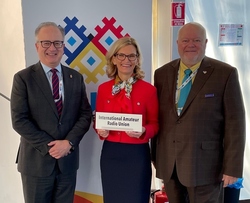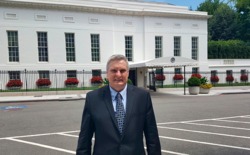 September 29, 2022 John E. Ross, KD8IDJ, Editor
| ||||||
Amateur Radio Operators Continue Response to Hurricane Ian As Hurricane Ian made its way across Florida, and now heads toward South Carolina, amateur radio operators have continued to provide communications support for weather updates and requests for assistance.
The hurricane made landfall at 3:00 PM Eastern Time on Wednesday, September 28, 2022, just south of Tampa, Florida, as a Category 4 hurricane with winds of 150 miles per hour. Millions of residents are without power, and damage was reported as extensive along the storm's initial path. As of 5 PM ET on Thursday, the National Hurricane Center (NHC) reported that Ian is "taking aim at the Carolinas and Georgia with life-threatening flooding, storm surge, and strong winds." ARRL Director of Emergency Management Josh Johnston, KE5MHV, has been in regular contact with ARRL Section Managers and Section Emergency Coordinators in Florida and throughout the southeastern US. Johnston said ARRL is also in touch with national-level partners, including FEMA and the Cybersecurity & Infrastructure Security Agency (CISA), should any requests for direct emergency communications via amateur radio be needed.
Johnston said many ARRL Amateur Radio Emergency Service® (ARES®) volunteers and their groups are involved across Florida, Georgia, and South Carolina. "Many ARES groups throughout Florida have been in a state of readiness since before the weekend," said Johnston. "These amateur radio volunteers are well-connected with their state and local emergency management partners in government and non-government organizations." Johnston also said that there are ARES members, at the request of the Florida Division of Emergency Management, serving in the state Emergency Operations Center. Many ARES groups are also operating in several shelter locations. ARRL has previously deployed Ham Aid kits in the region. The kits include amateur radio equipment for disaster response when communications equipment is unavailable. W1AW, the Maxim Memorial Station at ARRL's headquarters in Connecticut, has activated its Winlink station to handle PACTOR III and IV messages and traffic, as well as its SHARES station, NCS310.
"In our [ARRL's] experience, amateur radio's response will continue to play out, sometimes even more significantly, after the storm passes and communities enter a period of recovery," said Johnston. "As needs are assessed, such as disruptions to power and communications, our ARRL Section leaders and ARES groups may receive additional requests for more activations and deployments." Bobby Graves, KB5HAV, Net Manager for the Hurricane Watch Net (HWN), said the net is now transitioning from receiving weather data to gathering post-storm reports (read "Hurricane Watch Net Update for Ian," ARRL News, 9/29/2022). "These reports include damage and areas that are flooded," said Graves. "This gives the forecasters additional information they need. Also, since FEMA has an office in the National Hurricane Center, they look over these reports to get a bigger picture of what has happened, which in turn helps them to get help and humanitarian assistance where it is needed." Graves added that the HWN will be assisting with emergency, priority, and any Health and Welfare Traffic. The net may continue operations for days. The HWN will issue an after-action report to detail the number of amateur radio operators who participated on the net. Assistant HWN Net Manager Stan Broadway, N8BHL, said they have been filing reports since September 26, 2022, and over 125 specific reports have been filed to the NHC from stations in the area. "We have handled other reports, not included in the database, for damage and other storm-related situations," said Broadway. "One such call involved a relayed report of a woman trapped in her home with a collapsed wall in the Ft. Meyer area. That report was relayed to Lee County Emergency Communications to dispatch a rescue team." The VoIP Hurricane Net has been active as well. Director of Operations for the VoIP Hurricane Net and ARRL Eastern Massachusetts ARES Section Emergency Coordinator Rob Macedo, KD1CY, said the net will remain active potentially through 11:00 PM EDT on Thursday evening, supporting WX4NHC, the Amateur Radio Station at the National Hurricane Center in Miami, Florida. WX4NHC will be active through this period for as long as needed. Use these additional links for more information: FCC Grants an ARRL Emergency Request to Permit Higher Data Rate Transmissions for Hurricane Relief Communications
In its Order (DA 22-1011), the FCC concluded "that granting the requested waiver is in the public interest. Puerto Rico was recently hit by Hurricane Fiona and Hurricane Ian is predicted to cause significant damage, including disruption to electricity and communications services. Thus, to accommodate amateur radio operators assisting in the recovery efforts, we grant the ARRL's waiver request for the period of 60 days from the date of this Order to operate in any parts of the United States and its territories impacted by hurricanes. The waiver is limited to amateur radio operators in the United States and its territories using publicly documented data protocols that are compatible with FCC rules, with the exception of the data rate limit waived here, for those directly involved with HF hurricane relief communications." ARRL's request stated that trained amateur radio operators are working with emergency management officials and relief organizations to assist with disaster relief communications in anticipation of Hurricane Ian. ARRL sought the waiver for Amateur Radio Emergency Service® (ARES®) volunteers, and other amateur radio support groups working with federal, state, and local emergency management officials to assist with disaster relief. Pursuant to ARRL's request and similar to written waivers granted by the FCC in earlier years, three conditions must be met to qualify. A protocol or mode exceeding the 300 baud symbol rate limit must be publicly documented, use no more bandwidth than the currently permissible slower protocols (generally accepted to be the bandwidth of an SSB signal, or 2.8 kHz), and be used solely for communications related to hurricane relief. ARRL also explained that radio amateurs using higher-speed emissions for hurricane-related messages in the US and its territories must be able to communicate with similar stations in the US. They may also need the ability to communicate with Caribbean-based stations directly involved with hurricane relief efforts. Additionally, amateurs must be able to communicate with federal stations on the five channels in the 5 MHz band involved with the SHARES network and other interoperability partners on those frequencies. ARRL also pointed out that the past FCC temporary waivers have allowed such protocols in similar events, including hurricanes Maria, Dorian, Laura, and Ida, typhoon relief communications in Hawaii, and wildfires in the western areas of the US. In 2016, in response to an ARRL petition for rulemaking, the FCC proposed to remove the symbol rate limitations. It concluded that such limitations had become unnecessary due to advances in modulation techniques, and they no longer served a useful purpose. That proceeding, WT Docket 16-239, is still pending. Doreen Bogdan-Martin, KD2JTX, is Elected as Next ITU Secretary General The International Telecommunication Union (ITU), the United Nations specialized agency for information and communication technologies, has announced the election of Doreen Bogdan-Martin of the United States of America as the next ITU Secretary-General. Bogdan-Martin will assume office on January 1, 2023. She is radio amateur; call sign KD2JTX. The election took place during ITU's Plenipotentiary Conference (PP-22) in Bucharest, Romania, on Thursday, September 29, 2022. Bogdan-Martin won the position with 139 votes, out of 172 votes cast by representatives of Member States. Read the ITU press release.
"This is an exciting development for ITU," said International Amateur Radio Union (IARU) President Tim Ellam, VE6SH. "...she will be the first female SG [Secretary General] and only the third to hold an amateur license. Doreen has an exciting agenda for ITU." The US Department of State has published a statement from Bogdan-Martin, as well as her biography, and vision. "She will make an outstanding ITU Secretary-General and one IARU will be proud to work with on behalf of the Amateur Services," said Ellam. Brian Daly, WB7OML, Received AT&T Fellows Honor ARRL member Brian Daly, WB7OML, who the received the AT&T Fellows Honor in 2021, is being recognized by AT&T as a trailblazer in the telecommunications standards industry. The AT&T Fellows Honor is given to individuals in the AT&T technical community who have made sustained and notable contributions through scientific and technical achievements that have impacted AT&T's business.
Daly is the Assistant Vice President of Standards and Industry Alliances for AT&T and helped develop wireless services, including Wireless Emergency Alerts (WEA) and AT&T's nationwide public safety network FirstNet®. In the aftermath of 9/11, Daly was approached by the FCC after congress passed the Warning, Alert, and Response Network (WARN) Act to help develop a public warning system using cellular technology. Daly's team identified the technical and operational requirements for the technology and paved the way for WEA, which launched in 2012. "WEA were sent during the Boston Marathon bombing tragedy, Superstorm Sandy, throughout the COVID-19 pandemic, and in countless other emergencies," said Daly. "Knowing that I had something to do with the more than 70,000 WEA that have been deployed to inform and protect people in times of crisis over the past decade, and the fact that 123 children have been found thanks to WEA-delivered AMBER Alerts is one of the greatest rewards of doing what I do at AT&T." Daly continues to provide expertise to the Federal Emergency Management Agency (FEMA), the National Weather Service (NWS), the US Geological Survey (USGS), and state, local, and tribal agencies. He is also a volunteer for the FirstNet Response Operations Group and trained to deploy a dedicated FirstNet Satellite Cell on Light Truck (SatCOLT) to restore cell systems damaged by emergencies. Daly holds an Amateur Extra-class license and is a Technical Specialist for the ARRL Georgia Section. Club Grant Application Period Open Until November 4 The ARRL Foundation Club Grant Program opened a second grant proposal period which began September 7, 2022, and runs until November 4, 2022, at 7 PM Eastern Time. Radio clubs can apply now, and information about the program can be found on the ARRL website at www.arrl.org/club-grant-program. Following the first proposal period that ran earlier this year, 128 clubs applied for grants with a variety of outstanding projects. Emphasis is placed on projects that have a component of community involvement, training, new ham development, and club revitalization. Twenty-four clubs were chosen and nearly $270,000 was awarded. Clubs that applied in the first round and did not receive a grant are urged to reapply. The ARRL Foundation will award an additional $230,000 in grants at the end of the second application round. An informational webinar was held on September 7, and a recording of that event can be seen on ARRL's YouTube channel at https://youtu.be/ZNvc_eeIIwU. Amateur Radio in the News ARRL Public Information Officers, Coordinators, and many other member-volunteers help keep amateur radio and ARRL in the news. "Area Amateur Radio Operators to participate in Communications Exercise" / St. Louis Post - Dispatch (Missouri), September 19, 2022 -- Thanks to the St. Louis Metro ARES/RACES® team. "HAM RADIO OPERATOR KEEPS LIFELINES, PEOPLE AND EVENTS CONNECTED WHERE CELLPHONE TECHNOLOGY CANNOT" / Lebanon Local (Oregon), September 22, 2022 -- Lebanon Amateur Radio Emergency Services®. "MARSHALL COUNTY AMATEUR RADIO OPERATORS TO PARTICIPATE IN A DISTRICT WIDE COMMUNICATIONS EXERCISE" / WTAC (Indiana), September 22, 2022 -- Thanks to the Marshall County Amateur Radio Club and the Marshall County ARES/RACES® team. "Big E to host chat with International Space Station for local students" / WGGB Western Mass News (Massachusetts), September 26, 2022 -- Thanks to the ARRL New England Division. "Students to chat with International Space Station at Big E Tuesday" / WWLP (Massachusetts), September 26, 2022 "Ham radio is ready if cell phones go down" / SNN News (Florida), September 27, 2022 -- The Sarasota Emergency Radio Club is an ARRL Affiliated Club. "Ham operators hosting Simulated Emergency Test Oct. 8" / The Monroe News (Michigan), September 28, 2002 -- Thanks to the Monroe County Amateur Radio Public Service Corps and Monroe County Radio Communications Association, an ARRL Affiliated Club. Share any amateur radio media hits you spot with us.
ARRL Podcasts
The latest episode of the ARRL On the Air podcast includes QST contributor Dino Papas, KL0S. Papas provides insight into the construction and tuning of a J-pole antenna, which he built for On the Air from a design by John H. Unrath, K6JHU. Listen to ARRL Audio News, available every Friday. ARRL Audio News is a summary of the week's top news stories in the world of amateur radio and ARRL, along with interviews and other features. The On the Air podcast is available on iTunes (iOS) and Stitcher (Android). The On the Air podcast and ARRL Audio News are also on Blubrry -- On the Air | ARRL Audio News. Announcements The 70th Rock Hill Hamfest and 2022 ARRL South Carolina Section Convention, originally planned for October 1, 2022, has been postponed. The event sponsor, York County Amateur Radio Society (YCARS), said the postponement is due to the projected path of Hurricane Ian. YCARS announced that the make-up date will be Saturday, November 12, 2022. For more information, visit the YCARS website.
In Brief... There is still time to register for the 2022 NASA International Space Apps Challenge, running from October 1 - 2. One of this year's challenges is Calling All Radio Enthusiasts. Data from the Amateur Radio on the International Space Station (ARISS) broadcast and reception systems, as well as networks of ham radio broadcasters, can be utilized for applied heliophysics research. The challenge is to develop an application that uses these datasets to construct and display images of Earth's ionosphere. You can participate in person or virtually. Last year, over 28,000 participants competed from 162 countries and territories. Visit the Space Apps Challenge website to register and for more information.
The K7RA Solar Update Tad Cook, K7RA, of Seattle, Washington, reports for this week's ARRL Propagation Bulletin:
Sunspot activity rose this week, as the average daily sunspot numbers increased from 68 to 105.1. But solar flux? Not so much. The average daily solar flux rose from 134.3 to 138.4. So, the sunspot average rose 55% and solar flux rose only 3%. We usually expect the numbers to track closer. Tuesday, September 27, had lots of geomagnetic activity, with the planetary A index at 24 and middle latitude at 33. At www.spaceweather.com, blamed an unexpected CME for this activity. They also reported a huge sunspot beyond the sun's eastern horizon and a helioseismic image at https://bit.ly/3ftpTIN. The Australian Space Weather Forecasting Centre issued a geomagnetic warning at 2146 UTC on September 28, stating, "Geomagnetic 27-day recurrence patterns indicate that G1 geomagnetic activity is likely during the interval between September 30 and October 2. INCREASED GEOMAGNETIC ACTIVITY EXPECTED DUE TO CORONAL HOLE HIGH SPEED WIND STREAM." Predicted solar flux is 135 on September 29; 130 on September 30 through October 1; 125 on October 2 - 3; 120 on October 4 - 5; 132 on October 6 - 7; 135, 130, 128, and 132 on October 8 - 11; 136 on October 12 - 13; 138, 140, 138, and 135 on October 14 - 17; 132, 130, 128, and 125 on October 18 - 21; 130, 140, 142, and 145 on October 22 - 25, and 140, 135, 130, 125, 128, and 130 on October 26 - 31. Planetary A index is predicted at 8, 20, 60, and 40 on September 29 through October 2; 20, 18, 16, and 10 on October 3 - 6; 8 on October 7 - 14; 10 on October 15 - 16; 8 on October 17 - 19; 12 on October 20 - 21; 8 on October 22 - 23; 10 on October 24 - 25, and 8 on October 26 - 27. Then, in a recurrent disturbance as the sun rotates into the same position as weeks earlier, 25, 50, 30, 20, 12, and 10 on October 28 through November 2. Sunspot numbers for September 22 through 28, were 99, 111, 128, 96, 120, 110, and 72, with a mean of 105.1. The 10.7-centimeter flux was 136.7, 146.3, 146.5, 134.7, 135.1, 134.5, and 134.8, with a mean of 138.4. Estimated planetary A indices were 6, 12, 13, 7, 6, 24, and 5, with a mean of 10.4. Middle latitude A index was 5, 12, 10, 5, 5, 33, and 3, with a mean of 10.4. Send your tips, questions, or comments to k7ra@arrl.net. A comprehensive K7RA Solar Update is posted Fridays on the ARRL website. For more information concerning radio propagation, visit the ARRL Technical Information Service, read "What the Numbers Mean..." and check out the Propagation Page of Carl Luetzelschwab, K9LA. A propagation bulletin archive is available. For customizable propagation charts, visit the VOACAP Online for Ham Radio website. Share your reports and observations. A weekly, full report is posted on ARRL News.
Just Ahead in Radiosport
Visit the ARRL Contest Calendar for more events and information.
Upcoming Section, State, and Division Conventions
Search the ARRL Hamfest and Convention Database to find events in your area. Have News for ARRL? Submissions for The ARRL Letter and ARRL News can be sent to news@arrl.org. -- John E. Ross, KD8IDJ, ARRL News Editor
ARRL -- Your One-Stop Resource for
Subscribe to...
Free of charge to ARRL members...
| ||||||



 The Federal Communications Commission (FCC) has granted an
The Federal Communications Commission (FCC) has granted an 

.jpg)

-Blue.jpg)








